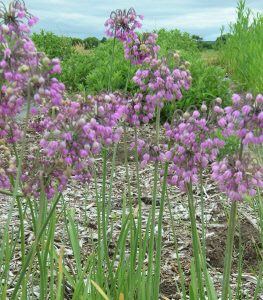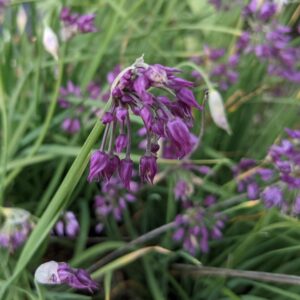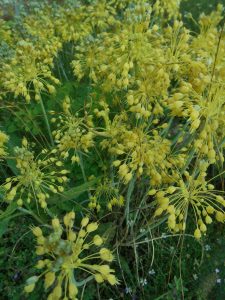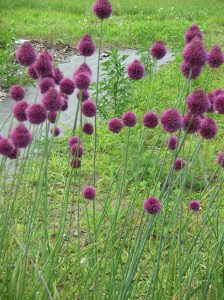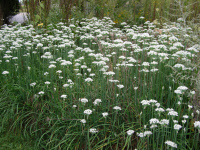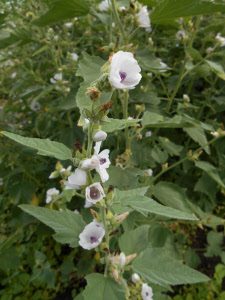Perennials & Biennials
Showing 17–24 of 485 results
-
Allium cernuum Nodding onion, Prairie onion Z 4-8
Umbels of arching stems with nodding bells of lilac shading to pink or occasionally white. May to June.
Umbels of arching stems with nodding bells of lilac shading to pink or occasionally white. May to June.
We are very sorry, but due to state agricultural restrictions, we are not permitted to ship Allium bulbs to Idaho, or to the following five counties in the State of Washington: Adams, Benton, Franklin, Grant and Klickitat.
Size: 12”-18”x 3-6”
Care: sun to part shade in moist well-drained soil
Native: Canada to Mexico
Wildlife Value: nectar source for Hairstreak butterfly, Attracts hummingbirds. Alliums resist critters including deer, rabbits, squirrels, mice, and moles and voles. They cannot stand the onion-like smell of Alliums protecting near-by plants too.Cernuum is Latin meaning “nodding.” Many groups of 1st Americans ate the bulbs raw, roasted or dried for winter storage or as flavoring for soups and gravies. Cherokee used this plant medicinally to cure colds, hives, colic, “gravel & dropsy,” liver ailments, sore throats, “phthisic,” and feet in “nervous fever.” Those in the Isleta Pueblo were not quite as creative as the Cherokee and used this only for sore throats and infections. Meriwether Lewis collected this in Montana and wrote, “I met with great quantities of a small onion about the size of a musquit ball … They were crisp, white and well-flavoured. I gathered about a half a bushel of them before the crew arrivd.” Chicago is believed to be named for the Algonquin word for this plant chigagou.
-
Allium cyathophorum var. farreri Z 5-8
Clusters of nodding deep purple tubes flowering atop scapes in late spring to early summer above shorter grassy leaves.
Clusters of nodding deep purple tubes flowering atop scapes in late spring to early summer above shorter grassy leaves.
We are very sorry, but due to state agricultural restrictions, we are not permitted to ship Allium bulbs to Idaho, or to the following five counties in the State of Washington: Adams, Benton, Franklin, Grant and Klickitat.
Size: 6-12” x 9-12"
Care: sun to part shade in moist to moist well-drained soil
Native: mountains of northwestern China.
Wildlife Value: Alliums resist critters including deer, rabbits, squirrels, mice, and moles and voles. They cannot stand the onion-like smell of Alliums protecting near-by plants too.1st described in 1930. This variety named to honor intrepid plant explorer, writer and artist Reginald Farrer (1880-1920).
-
Allium flavum var. minus Yellow flowered garlic
Umbels of shatter-shot yellow florets, like fireworks, bloom atop blue-green stems in July.
Umbels of shatter-shot yellow florets, like fireworks, bloom atop blue-green stems in July.
We are very sorry, but due to state agricultural restrictions, we are not permitted to ship Allium bulbs to Idaho, or to the following five counties in the State of Washington: Adams, Benton, Franklin, Grant and Klickitat.
Size: 10” x 3”
Care: sun in moist well-drained soil
Native: Northern Turkey
Wildlife Value: Resists critters including deer, rabbits, squirrels, mice, and moles and voles. They cannot stand the onion-like smell of Alliums protecting near-by plants too. Attracts bees & butterflies
Awards: species received Royal Horticultural Society Award of Garden MeritDescribed by Swiss botanist Pierre Edmond Boissier before 1885
-
Allium senescens Corkscrew allium, German garlic, Greater mountain garlic Z 4-9
Lavender balls, up to 30 of them, atop thin, bluish, strap-like, twisting foliage – mid-summer day’s dream.
Lavender balls, up to 30 of them, atop thin, bluish, strap-like, twisting foliage – mid-summer day’s dream.
We are very sorry, but due to state agricultural restrictions, we are not permitted to ship Allium bulbs to Idaho, or to the following five counties in the State of Washington: Adams, Benton, Franklin, Grant and Klickitat.
Size: 6-12” x 6-12”
Care: sun to part shade in well-drained to moist well-drained soil
Native: Siberia
Wildlife Value: Attracts butterflies & bees. Resists critters including deer, rabbits, squirrels, mice, and moles and voles. They cannot stand the onion-like smell of Alliums protecting near-by plants too.Cultivated before 1753. According to Philip Miller’s 1768 Dictionary, “planted in gardens for the variety of their flowers.” Grown at America’s 1st botanic garden, Elgin Botanic Garden 1811.
-
Allium sphaerocephalon Drumstick allium Z 4-11
Claret colored, egg shaped flower heads
Claret colored, egg shaped flower heads top leafless stems in June to July. Good see-through plant to intermingle with purple coneflowers or tickseed. Good cut flower. Self-sows
We are very sorry, but due to state agricultural restrictions, we are not permitted to ship Allium bulbs to Idaho, or to the following five counties in the State of Washington: Adams, Benton, Franklin, Grant and Klickitat.
Size: 2-3’ x 2-3”
Care: sun in well-drained to moist well-drained soil.
Native: Mediterranean, Caucasus & Europe
Wildlife Value: attracts bees, butterflies and other insects.In gardens before 1750. Used as an edging around vegetables at Mount Vernon.
Allium sphaerocephalon is perhaps the most rugged, most enduring and most ubiquitous of all Alliums. It is indigenous to the lands of Great Britain, Europe, the Middle East, parts of Africa to as far west as the Caucasus mountains. It grows in the worst of soils and is tolerant of and appreciative of summer rains which distinguishes it from most other Alliums. It is also able to survive severe drought conditions. -
Allium tuberosum Garlic chives Z 4-8
August & September bright white balls the size of golf balls on erect stems. Ornamental in gardens and in arrangements, both fresh and dried, delicious edible.
August & September bright white balls the size of golf balls on erect stems. . Ornamental in gardens and in arrangements, both fresh and dried, delicious edible.
We are very sorry, but due to state agricultural restrictions, we are not permitted to ship Allium bulbs to Idaho, or to the following five counties in the State of Washington: Adams, Benton, Franklin, Grant and Klickitat.
Size: 12-18” x 8”
Care: Full sun or shade in any soil
Native: Southeast Asia
Wildlife Value: nectar source for many butterlies including the Tiger Swallowtail. Resists critters including deer, rabbits, squirrels, mice, and moles. They cannot stand the onion-like smell of Alliums protecting near-by plants too.Used medicinally in Asia as a remedy for incontinence, bladder weakness, kidney trouble and knee injuries. Traditional Chinese medicine practitioners made a powder from the seeds called Jiu Cai Zi used for numerous ailments.
-
Althaea officinalis Marshmallow Z 4-9
Small pale pink mallow-like blooms climb tall spires from July to September
Small pale pink mallow-like blooms climb tall spires from July to September
Size: 5-6’ x 3’
Care: Full sun moist to moist well-drained fertile soil. Heat and drought tolerant, stands up to wind with no staking needed.
Native: Central, south and east EuropeAlthaea is Greek meaning “to cure.” This was identified by Dioscorides in De Materica Medica for medicinal use around 70 A.D. More than 2000 years ago ancient Egyptians added honey to the cooked root. Ancient Romans used leaves and flowers as a strewing herb to repel lice and fleas. Emperor Charlemagne (742-814) cultivated the marshmallow in his gardens. According to Nicholas Culpepper, 16th century English herbalist, marshmallows were a medicinal candy. The plant eased pain, helped bloody fluxes, the stone and gravel and gripping of the belly. The marshmallow was considered to be an herb of Venus meaning that it voided offensive humors, made milk for nursing, cured bee stings, dandruff, balding and coughs. The French concocted the fluffy white confection in the mid 1800’s “from a decoction of marshmallow root, with gum to bind the ingredients together, beaten egg white to give lightness and to act as a drying agent, while sugar was incorporated to make the whole palatable.” American gardens since 1700’s when John Bartram received seeds from Europe. Jefferson grew it at Monticello. Grown at America’s 1st botanic garden, Elgin Botanic Garden 1811.
-
Amsonia hubrichtii Thread leaf amsonia, Arkansas amsonia Z 5-8
Powder-blue flowers in early summer; feathery foliage turns caution-sign yellow in fall.
Powder-blue flowers in early summer; feathery foliage turns caution-sign yellow in fall.
Size: 2-3’ x 2-3’
Care: sun to part shade in moist well-drained soil
Native: Central-So, US
Wildlife Value: attracts butterflies & bees
Awards: Missouri Botanic Garden Plant of Merit; Pennsylvania Horticultural Society Gold Medal; and Mount Cuba Center, botanic garden in Delaware, trialed several Amsonias and gave this its highest rating.Collected in 1940 in Yell County Arkansas along a stream 3 miles west of Birta.

